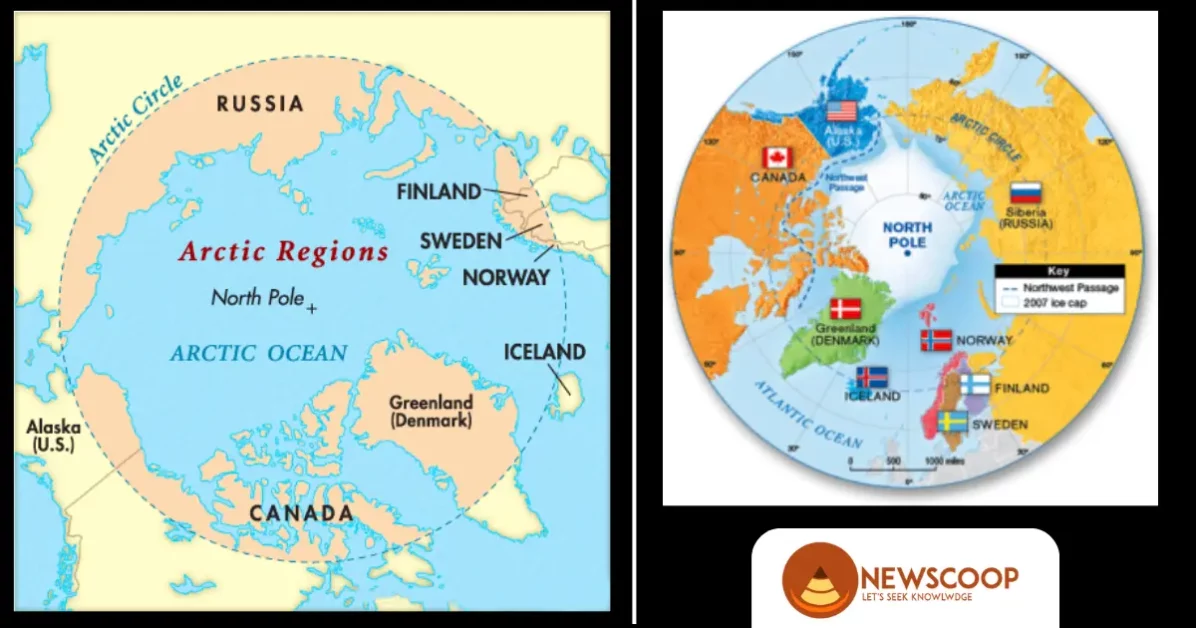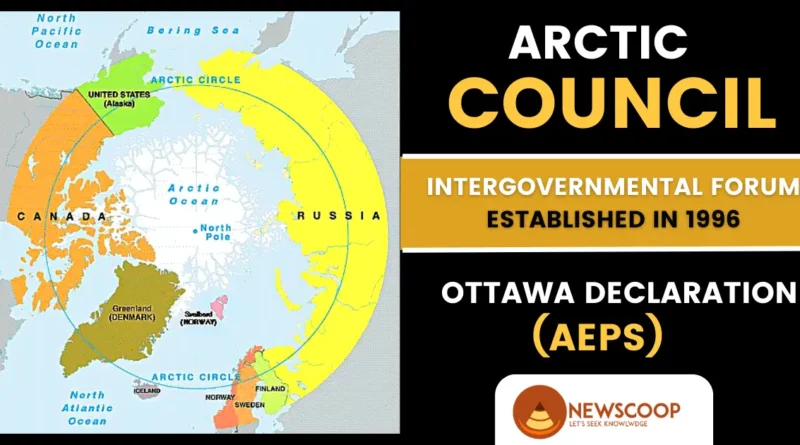Arctic Council: Member Countries & Objectives | UPSC
In this article, we will explore the Arctic Council and its crucial role in promoting cooperation and environmental stewardship in the Arctic region. We will also discuss the Council’s structure, objectives, achievements, and future challenges, focusing on its efforts to address climate change, conserve biodiversity, and navigate the region’s rapidly changing dynamics.
Join us as we delve into the significance of the Arctic Council in shaping policies and advancing sustainable development in this critical part of the world.
What is Arctic Council?
The Arctic Council is an intergovernmental forum established in 1996 to promote cooperation among Arctic states and indigenous peoples in addressing common challenges and opportunities in the Arctic region. It serves as a platform for dialogue, collaboration, and the formulation of policies to ensure sustainable development, environmental protection, and the well-being of the Arctic and its inhabitants.
Members of the Arctic Council
The Arctic Council consists of eight member states, known as the Arctic States. These states have territories within the Arctic region and play a crucial role in shaping policies and decisions in the Council. The member states of the Arctic Council, as per the Ottawa Declaration, are:
- Canada
- Denmark (including Greenland and the Faroe Islands)
- Finland
- Iceland
- Norway
- Russia
- Sweden
- United States
These member states are considered the stewards of the Arctic region, and their national jurisdictions, along with international law, govern the lands surrounding the Arctic Ocean and its waters.
The Northern provinces of the Arctic States are home to more than four million people, and the well-being and health of these communities are among the top priorities on the Arctic Council’s agenda. Together, the member states work collaboratively to address the challenges and opportunities in the Arctic region and promote sustainable development, environmental protection, and the well-being of Arctic communities.

Permanent Participants in the Arctic Council
The Arctic Council recognizes the important role of indigenous peoples in the governance of the Arctic region through the concept of Permanent Participants. These indigenous organizations have a special status within the Council, providing valuable insights, traditional knowledge, and perspectives on Arctic-related issues.
The number of Permanent Participants in the Arctic Council has evolved over time, with the inclusion of different organizations in two stages:
- 1998: Aleut International Association (AIA): The AIA, representing the Aleut people, became the fourth Permanent Participant in the Arctic Council. The Aleut people reside in regions spanning Alaska, Russia’s Kamchatka Peninsula, and the Aleutian Islands.
- 2000: Arctic Athabaskan Council (AAC) and Gwich’in Council International (GGI): In 2000, two more organizations were appointed as Permanent Participants. The AAC, representing Athabaskan indigenous communities in Alaska, Canada, and Russia, joined as a Permanent Participant. The GGI, representing the Gwich’in people living in Alaska and Canada, also became a Permanent Participant.
These organizations, as Permanent Participants, actively participate in Arctic Council meetings, working groups, and other activities. They bring their unique perspectives, knowledge, and experiences to the discussions, ensuring the inclusion of indigenous voices in decision-making processes.
Observer Status in the Arctic Council
In addition to the Arctic States and Permanent Participants, the Arctic Council also grants Observer status to non-Arctic states, intergovernmental organizations, inter-parliamentary organizations, global and regional organizations, and non-governmental organizations that can contribute to the Council’s work. The decision to grant Observer status is approved by the Council at the Ministerial Meetings, which take place every two years.
Observers primarily engage with the Arctic Council through their participation in the Council’s Working Groups. They provide valuable contributions, expertise, and perspectives on various Arctic-related issues. However, it’s important to note that Observers do not have voting rights in the Council.
As of 2022, there are thirteen non-Arctic states that have been granted Observer status in the Arctic Council. These include:
- Germany (Observer status since 1998)
- Netherlands (Observer status since 1998)
- Poland (Observer status since 1998)
- United Kingdom (Observer status since 1998)
- France (Observer status since 2000)
- Spain (Observer status since 2006)
- China (Observer status since 2013)
- India (Observer status since 2013)
- Italy (Observer status since 2013)
- Japan (Observer status since 2013)
- South Korea (Observer status since 2013)
- Singapore (Observer status since 2013)
- Switzerland (Observer status since 2017)
These non-Arctic states contribute to the work of the Arctic Council by sharing their expertise, research, and perspectives on various Arctic-related issues. Their involvement as Observers further enhances international cooperation and collaboration in addressing the challenges and opportunities in the Arctic region.
Key Objectives & Priorities
The Arctic Council focuses on several key objectives and priorities to address the unique challenges and opportunities presented by the Arctic region:
- Environmental Protection: The Council is committed to preserving the Arctic’s fragile ecosystems, promoting sustainable resource management, and mitigating the impacts of climate change. It fosters scientific research and monitors environmental changes to develop effective strategies for conservation.
- Indigenous Engagement: Recognizing the rights and traditional knowledge of indigenous peoples, the Council aims to enhance their participation and integrate their perspectives into decision-making processes. This inclusive approach promotes cultural preservation, improves living conditions, and respects indigenous rights.
- Sustainable Development: The Council strives to promote sustainable development in the Arctic region, balancing economic growth with environmental protection. It encourages responsible resource extraction, tourism, and infrastructure development while minimizing ecological harm and safeguarding local communities.
- Scientific Cooperation: The Arctic Council actively supports scientific research and data sharing to improve understanding of the region’s complex systems. This scientific collaboration helps inform policy decisions, assess risks, and develop effective responses to climate change and other environmental challenges.
History of the Arctic Council
The Arctic Council was established as a result of the Arctic Environmental Protection Strategy (AEPS) in 1991. The AEPS aimed to foster intergovernmental cooperation on environmental protection among the Arctic States.
Recognizing the importance of indigenous peoples in the Arctic, three Indigenous Peoples Organizations (IPOs) were welcomed as observers in the AEPS. The IPOs represented Inuit, Saami, and Russian indigenous peoples. The Arctic Council was formed in 1996, building upon the AEPS, and expanded its scope to cover a wider range of issues.
The Council granted special status to the IPOs, known as Permanent Participants (PPs), who have the right to fully participate in the Council’s work, including decision-making. The inclusion of the PPs reflects the recognition of the unique relationship of indigenous peoples to the Arctic.
Their involvement ensures that their perspectives and traditional knowledge are considered in shaping policies and decisions for the region’s sustainable development, environmental protection, and the well-being of Arctic communities.
Working Groups of the Arctic Council
The Arctic Council operates through the collaborative efforts of its six Working Groups, each focusing on specific areas of priority for the Arctic region. These Working Groups play a crucial role in conducting research, providing assessments, and developing recommendations to address the challenges and opportunities in their respective fields. Here is a brief overview of the six Working Groups:
- Arctic Monitoring and Assessment Programme (AMAP): AMAP is responsible for monitoring and assessing the state of the Arctic environment, ecosystems, and human populations. It conducts scientific research, collects data, and provides recommendations on issues such as climate change, pollution, and sustainable development. AMAP’s work aims to inform policymakers and support decision-making processes with scientific evidence.
- Conservation of Arctic Flora and Fauna (CAFF): CAFF focuses on the conservation and sustainable management of Arctic biodiversity. Its work includes promoting the conservation of Arctic species, monitoring the status of ecosystems, and addressing threats to biodiversity. CAFF collaborates with indigenous peoples, local communities, and scientific experts to develop strategies for the protection and sustainable use of Arctic flora and fauna.
- Emergency Prevention, Preparedness, and Response (EPPR): EPPR addresses the prevention, preparedness, and response to emergencies and accidents in the Arctic region. It develops guidelines and best practices for preventing and responding to incidents such as oil spills, hazardous substance releases, and search and rescue operations. EPPR works towards enhancing cooperation and coordination among Arctic states to ensure effective emergency response capabilities.
- Protection of the Arctic Marine Environment (PAME): PAME’s primary focus is on the protection and sustainable use of the Arctic marine environment. It addresses issues related to shipping, oil and gas activities, marine pollution, and ecosystem-based management. PAME develops guidelines, promotes best practices, and facilitates cooperation among Arctic states to safeguard the fragile marine ecosystems of the Arctic.
- Sustainable Development Working Group (SDWG): SDWG is dedicated to promoting sustainable development and improving the well-being of Arctic communities. It focuses on issues such as economic development, health, education, infrastructure, and social and cultural aspects. SDWG collaborates with indigenous peoples, local communities, and stakeholders to identify challenges, develop strategies, and implement initiatives that support sustainable development in the Arctic.
- Arctic Contaminants Action Program (ACAP): ACAP addresses the reduction and prevention of pollutants and contaminants in the Arctic environment. It focuses on issues such as persistent organic pollutants, heavy metals, and radioactive substances. ACAP develops strategies, promotes best practices, and supports projects to minimize the release and impact of contaminants in the Arctic region.
These Working Groups play a vital role in providing scientific knowledge, conducting assessments, and formulating recommendations to inform the decision-making processes of the Arctic Council. Through their collaborative efforts, they contribute to the sustainable development and protection of the Arctic region and its communities.
Legally Binding Agreement
| Agreement | Year | Location | Focus |
|---|---|---|---|
| Cooperation on Aeronautical and Maritime Search and Rescue | 2011 | Nuuk, Greenland | Cooperation in Aeronautical and Maritime Search and Rescue |
| Cooperation on Marine Oil Pollution Preparedness and Response | 2013 | Kiruna, Sweden | Enhancing Cooperation in search and rescue operations in the Arctic Environment |
| Enhancing International Arctic Scientific Cooperation | 2017 | Fairbanks, Alaska | Facilitating international scientific cooperation and collaboration in the Arctic region |
India and the Arctic
India, despite being a non-Arctic state, has shown a growing interest in the Arctic region due to the emerging opportunities and challenges associated with climate change and the melting of the Arctic ice cap. Here are some key points highlighting India’s engagement with the Arctic:
- Scientific Expeditions and Research Base: In 2007, India launched its first scientific expedition to the Arctic Ocean, marking its entry into Arctic research. The country established the research base named “Himadri” at the International Arctic Research Base in Ny-Alesund, Svalbard, Norway, in July 2008. The base facilitates studies in disciplines such as glaciology, atmospheric sciences, and biological sciences.
- Interests in the Arctic: India’s interests in the Arctic span scientific, environmental, commercial, and strategic aspects. The country has been closely monitoring developments in the region, particularly with regard to the implications of global warming and the melting of the Arctic ice cap.
- Renaming of Research Center: In July 2018, India’s Ministry of Earth Sciences renamed the Goa-based “National Centre for Antarctic and Ocean Research” to the “National Centre for Polar and Ocean Research.” This nodal organization coordinates research activities at the poles and reflects India’s broader engagement in polar research.
- International Collaborations: India has entered into memoranda of understanding (MOUs) with institutions such as the Norwegian Polar Research Institute and Kings Bay, a Norwegian government-owned company. These collaborations facilitate cooperation in scientific research and provide logistic and infrastructure support for India’s Arctic research activities, including the maintenance of the Indian research base “Himadri.”
- Observer Status in the Arctic Council: In 2019, India was re-elected as an Observer to the Arctic Council, solidifying its role as an active participant in Arctic affairs. As an Observer, India contributes to discussions and initiatives related to the Arctic Council’s work, despite not having an official Arctic policy.
- Research Objectives: India’s Arctic research objectives have primarily focused on ecological and environmental aspects, with a particular emphasis on studying climate change. The country’s research activities aim to enhance scientific understanding of the Arctic and its impact on global climate systems.
India’s engagement with the Arctic reflects its recognition of the region’s significance in the global context. Through scientific research, collaborations, and participation in the Arctic Council, India contributes to international efforts aimed at addressing the challenges and opportunities arising from the changing Arctic environment.
Must Read: Other International Organizations
Objectives of Indian Research in the Arctic Region
The objectives of Indian research in the Arctic region are:
Studying Arctic-Indian Monsoon Teleconnections: Analyzing sediment and ice core records from Arctic glaciers and the Arctic Ocean to understand the hypothesized teleconnections between the Arctic climate and the Indian monsoon. This research aims to uncover potential relationships and impacts on the Indian monsoon system.
Characterizing Arctic Sea Ice: Utilizing satellite data to study and characterize sea ice in the Arctic region. The focus is on estimating the effects of global warming on the extent and properties of sea ice in the northern polar region.
Researching Arctic Glacier Dynamics and Mass Budget: Conducting research on the dynamics and mass budget of Arctic glaciers, with a specific focus on understanding the role of glaciers in sea-level change. This research contributes to a comprehensive understanding of the response of Arctic glaciers to climate change.
Assessing Arctic Flora and Fauna: Undertaking a comprehensive assessment of the Arctic’s flora and fauna and their responses to anthropogenic activities. This research aims to document and understand the impact of human activities on the Arctic ecosystem and contribute to biodiversity conservation efforts.
Comparative Study of Life Forms in Polar Regions: Proposing a comparative study of life forms from both the Arctic and Antarctic regions. This research enables a better understanding of the unique adaptations, ecological processes, and similarities/differences between the Polar Regions.
Conclusion
The Arctic Council serves as a vital platform for Arctic states and indigenous peoples to address the complex challenges and opportunities in the Arctic region. Through its cooperative efforts, the Council aims to promote environmental protection, sustainable development, and the well-being of Arctic communities.
As the Arctic continues to undergo rapid changes, the Council’s role in fostering dialogue, scientific collaboration, and policy formulation becomes increasingly important in ensuring a resilient and sustainable future for the region and its inhabitants.
Thank You!

